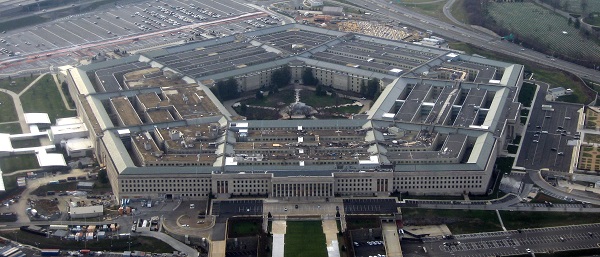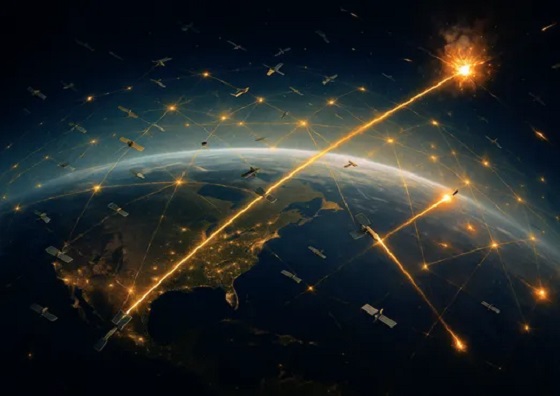International
Pentagon Salivates Over ‘Expensive’ Weapons While China Races Into Future With Iron Grip Over Cheap Drone Tech


From the Daily Caller News Foundation
By Wallace White
China is running away with critical drone technology while the U.S. struggles to even get into the race, with experts warning that the technological gap spells a “nightmare” scenario for America’s military on the battlefield.
Chinese company Da Jiang Industries (DJI) currently controls 70% of the worldwide commercial drone market alone, and American drone companies specializing in defense applications still rely heavily on Chinese parts to make their products, according to Forbes. The U.S.’ inability to match China’s drone production poses a major threat to national security, according to defense experts, with one source of the problem being the military’s insistence on developing “exquisite” weapons systems that have big price tags.
“China has captured 90% of the global market for small civilian drones by directly subsidizing drone manufacturers,” Bret Boyd, CEO of defense-oriented logistics firm Sustainment, told the Daily Caller News Foundation. “This has allowed them to be extremely competitive on price, undercutting most of their competitors and receiving huge benefits from economies of scale. This has been happening for decades.”
The 2025 National Defense Authorization Act (NDAA) included a review of the effect of using Chinese-made parts for domestic drone manufacturing, with DJI saying in a press release that the law was based on “xenophobic fear.” New York Republican Rep. Elise Stefanik attempted to add formal restrictions on Chinese parts into the NDAA, but the law only passed the house before stalling in the Committee on Commerce, Science and Transportation.
DJI sued the Pentagon in October over its inclusion on the department’s Chinese military company list. The case is ongoing.
The U.S. currently utilizes mostly high-cost, plane-like drones such as the MQ-9 Reaper, which specializes in air-to-ground attacks with missiles. An MQ-9 costs around $56.5 million to build per unit, according to the Air Force.
Since October 2023, Houthi rebels in Yemen have brought down at least six Reaper drones, according to ABC News in April. Meanwhile, Houthis have found great success with small, cheaply-made drones, with some having the range to fly nearly 16 hours to targets in Israel, according to Armed Conflict Location and Event Data (ALCED).
Moreover, the Houthis have killed an estimated 470 people with suicide drones since 2016, according to ALCED. By contrast, the drones can cost as little as $2,000, experts told Politico in 2023.
The enormous gap in the cost to wage war presents a unique national security risk that the Pentagon must urgently tackle, Boyd told the DCNF.
“Our military has become far too reliant on exquisite, expensive weapon systems that can only be built by a very small percentage of the American industrial base,” Boyd told the DCNF. “While this was appropriate for the Cold War, we need to adapt to the realities of combat in 2025. Ukraine is showing us that the modern battlefield is going to be dominated by ‘good enough’ technology deployed at scale.”
Cheap drones have fundamentally changed the battlefield, most exemplified by their extensive use in the Russia-Ukraine war beginning in 2022. The drones allowed Ukrainian and Russian soldiers alike to deal with tanks and other armored vehicles without exposing themselves with traditional anti-tank weapons systems like rocket launchers, according to The New York Times.
“These drones allow these service members to destroy a tank from 20 kilometers away,” William Thibeau, director of the American Military Project at the Claremont Institute and Army Ranger veteran, told the DCNF. “When you’re used to being threatened at only two and a half kilometers away, it changes the whole dynamic of how you move around and how you find cover and concealment.”
The air duel.
A Ukrainian FPV drone destroyed a russian Lancet drone that tried to escape its fate.📹: 93rd Mechanized Brigade pic.twitter.com/R8BfrGIMNE
— Defense of Ukraine (@DefenceU) October 30, 2024
In the Bakhmut region alone in Ukraine, drones killed nearly 210 Russian Wagner Group mercenaries and wounded 360 more over the course of months in mid-2023, the NYT reported.
“The question is, are we ready for drone on drone warfare, or are we still putting humans in the loop?,” a former defense engineer granted anonymity to freely discuss U.S. military policy, told the DCNF. “Because as far as I know, we’re still putting humans out there, and human against drone is a nightmare.”
The U.S. armed forces have already made some headway into adopting small drones for combat, with the Army creating “hunter-killer” platoons equipped with drones used for mainly reconnaissance. Most recently, Defense Secretary Pete Hegseth directed the Army to investigate the use of “low-cost” drones in strike applications as part of a $36 billion overhaul of the service branch.
“Ukraine set up this infrastructure from basically nothing, and it happened in garages, and they set it up in less than two years,” Thibeau told the DCNF. “We don’t want to figure this out after the shooting starts.”
Business
Canada’s critical minerals are key to negotiating with Trump

From Resource Works
The United States wants to break its reliance on China for minerals, giving Canada a distinct advantage.
Trade issues were top of mind when United States President Donald Trump landed in Kananaskis, Alberta, for the G7 Summit. As he was met by Prime Minister Mark Carney, Canada’s vast supply of critical minerals loomed large over a potential trade deal between North America’s two largest countries.
Although Trump’s appearance at the G7 Summit was cut short by the outbreak of open hostilities between Iran and Israel, the occasion still marked a turning point in commercial and economic relations between Canada and the U.S. Whether they worsen or improve remains to be seen, but given Trump’s strategy of breaking American dependence on China for critical minerals, Canada is in a favourable position.
Despite the president’s early exit, he and Prime Minister Carney signed an accord that pledged to strike a Canada-US trade deal within 30 days.
Canada’s minerals are a natural advantage during trade talks due to the rise in worldwide demand for them. Without the minerals that Canada can produce and export, it is impossible to power modern industries like defence, renewable energy, and electric vehicles (EV).
Nickel, gallium, germanium, cobalt, graphite, and tungsten can all be found in Canada, and the U.S. will need them to maintain its leadership in the fields of technology and economics.
The fallout from Trump’s tough talk on tariff policy and his musings about annexing Canada have only increased the importance of mineral security. The president’s plan extends beyond the economy and is vital for his strategy of protecting American geopolitical interests.
Currently, the U.S. remains dependent on China for rare earth minerals, and this is a major handicap due to their rivalry with Beijing. Canada has been named as a key partner and ally in addressing that strategic gap.
Canada currently holds 34 critical minerals, offering a crucial potential advantage to the U.S. and a strategic alternative to the near-monopoly currently held by the Chinese. The Ring of Fire, a vast region of northern Ontario, is a treasure trove of critical minerals and has long been discussed as a future powerhouse of Canadian mining.
Ontario’s provincial government is spearheading the region’s development and is moving fast with legislation intended to speed up and streamline that process. In Ottawa, there is agreement between the Liberal government and Conservative opposition that the Ring of Fire needs to be developed to bolster the Canadian economy and national trade strategies.
Whether Canada comes away from the negotiations with the US in a stronger or weaker place will depend on the federal government’s willingness to make hard choices. One of those will be ramping up development, which can just as easily excite local communities as it can upset them.
One of the great drags on the Canadian economy over the past decade has been the inability to finish projects in a timely manner, especially in the natural resource sector. There was no good reason for the Trans Mountain pipeline expansion to take over a decade to complete, and for new mines to still take nearly twice that amount of time to be completed.
Canada is already an energy powerhouse and can very easily turn itself into a superpower in that sector. With that should come the ambition to unlock our mineral potential to complement that. Whether it be energy, water, uranium, or minerals, Canada has everything it needs to become the democratic world’s supplier of choice in the modern economy.
Given that world trade is in flux and its future is uncertain, it is better for Canada to enter that future from a place of strength, not weakness. There is no other choice.
International
Trump puts new price tag on Canada joining “Golden Dome”

Quick Hit:
President Trump has upped the cost for Canada to join the U.S. “Golden Dome” missile defense program to $71 billion—$10 billion more than his previous ask.
Key Details:
- Trump confirmed the new $71 billion figure while speaking to reporters aboard Air Force One.
- Canada has pushed back, with PM Mark Carney and diplomats calling Trump’s offer a “protection racket.”
- Trump said Canada could access the system for free if it became the 51st U.S. state.
Diving Deeper:
President Trump has put a new and steeper price on Canada’s potential entry into America’s “Golden Dome” missile defense program. Speaking from Air Force One on Monday, Trump told reporters, “They want to be in… Seventy-one billion they’re going to pay.”
That’s a $10 billion increase from the $61 billion figure Trump had previously floated, marking a sharp escalation in his negotiations with Ottawa. The Golden Dome, described by the administration as a “state-of-the-art” defense shield, aims to protect North America from a new era of missile threats—particularly those posed by China, Russia, and North Korea.
Trump has framed the Golden Dome as the long-awaited realization of Ronald Reagan’s “Star Wars” vision, using space-based sensors and interceptors to strike down incoming ballistic, cruise, or hypersonic missiles. Development timelines suggest full deployment is still 5–7 years off, but an initial $25 billion is already allocated in next year’s defense budget. The entire project may run upwards of $175 billion, with some estimates as high as $542 billion over 20 years.
Canada, which has long partnered with the U.S. under NORAD to detect airborne threats, has expressed interest in joining the project. But Trump is demanding a separate, costly buy-in. He reiterated that Ottawa would “have to pay a lot of money” to participate unless it pursued a full political union with the U.S. “It would be free if Canada became the 51st state,” he added.
Canadian leaders have pushed back hard. Prime Minister Mark Carney, re-elected in April after campaigning against U.S. interference, said Canada wants to protect its citizens but not under terms dictated from Washington. Ambassador to the U.N. Bob Rae went further, calling Trump’s offer a “protection racket.”
-

 Business2 days ago
Business2 days agoCarney praises Trump’s world ‘leadership’ at G7 meeting in Canada
-

 Business1 day ago
Business1 day agoThe CBC is a government-funded giant no one watches
-

 conflict2 days ago
conflict2 days agoTrump leaves G7 early after urging evacuation of Tehran
-

 conflict1 day ago
conflict1 day agoMiddle East clash sends oil prices soaring
-

 Business2 days ago
Business2 days agoTrump family announces Trump Mobile: Made in America, for America
-

 Also Interesting2 days ago
Also Interesting2 days agoHow to Use Bonuses at Magius Casino and Similar Websites
-

 conflict1 day ago
conflict1 day agoTrump Threatens Strike on Khamenei as Israel Pounds Iranian Military Command
-

 Alberta1 day ago
Alberta1 day agoAlberta is investing up to $50 million into new technologies to help reduce oil sands mine water






